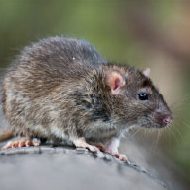Smooth brown or black fur and gray with white or black underside; pointed nose and long, scaly tail; around 16 inches in length, including tail

Diet: Roof rats are omnivores and food hoarders with a preference for seeds, fruits, and nuts but they will feed on almost anything available including grains, meat, and even tree bark. They forage for food in groups of up to ten and tend to return to the same food source time after time.
Habitat: Roof rats are nocturnal by nature, live in colonies, and are highly adaptable. They prefer to live in high places such as rafters or attics but will live wherever necessary including piles of rubbish or wood, and around or in structures.
Threats: Roof rats spread fleas and diseases, contaminate food and surfaces with their droppings, and can cause extensive damage to electrical wires, insulation, and furniture.
Control: To prevent roof rats from entering a home, seal up any holes or cracks larger than a quarter and secure windows with fitted screens. Keep trees and shrubs trimmed away from the structure and cut back limbs overhanging the roof. If you have fruit trees, remove any discarded fruit on the ground to eliminate the accessible food sources. You should also regularly inspect your home for signs of infestation including gnaw marks, damaged furniture or boxes, and droppings.








